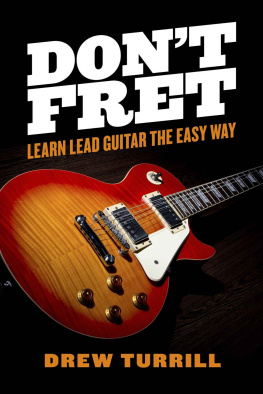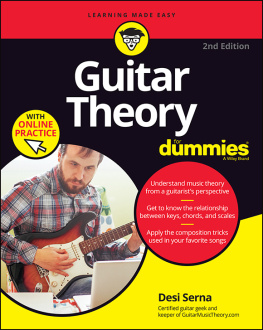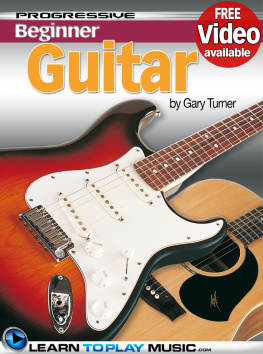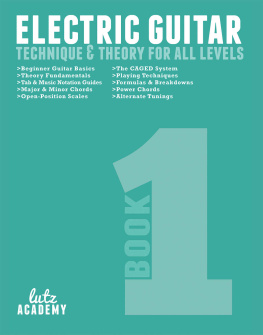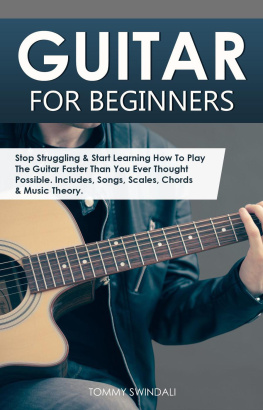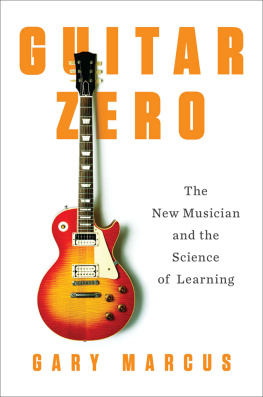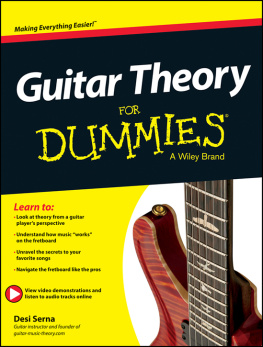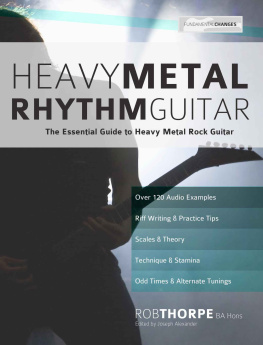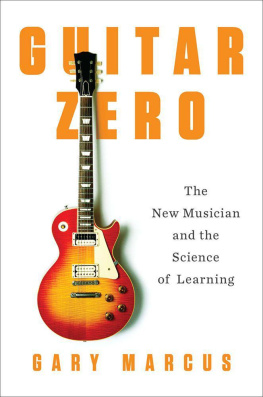Turrill - Dont Fret: Learn Lead Guitar the Easy Way
Here you can read online Turrill - Dont Fret: Learn Lead Guitar the Easy Way full text of the book (entire story) in english for free. Download pdf and epub, get meaning, cover and reviews about this ebook. year: 2015, publisher: BookBaby, genre: Children. Description of the work, (preface) as well as reviews are available. Best literature library LitArk.com created for fans of good reading and offers a wide selection of genres:
Romance novel
Science fiction
Adventure
Detective
Science
History
Home and family
Prose
Art
Politics
Computer
Non-fiction
Religion
Business
Children
Humor
Choose a favorite category and find really read worthwhile books. Enjoy immersion in the world of imagination, feel the emotions of the characters or learn something new for yourself, make an fascinating discovery.
Dont Fret: Learn Lead Guitar the Easy Way: summary, description and annotation
We offer to read an annotation, description, summary or preface (depends on what the author of the book "Dont Fret: Learn Lead Guitar the Easy Way" wrote himself). If you haven't found the necessary information about the book — write in the comments, we will try to find it.
Turrill: author's other books
Who wrote Dont Fret: Learn Lead Guitar the Easy Way? Find out the surname, the name of the author of the book and a list of all author's works by series.
Dont Fret: Learn Lead Guitar the Easy Way — read online for free the complete book (whole text) full work
Below is the text of the book, divided by pages. System saving the place of the last page read, allows you to conveniently read the book "Dont Fret: Learn Lead Guitar the Easy Way" online for free, without having to search again every time where you left off. Put a bookmark, and you can go to the page where you finished reading at any time.
Font size:
Interval:
Bookmark:
ISBN: 9781483550978
Table of Contents
Intro
You bought this book because you have a dream of playing lead guitar like your favorite guitar players. Whether youre just learning the instrument or have been playing for a while, youve likely learned a few chords and some songs you always wanted to play, but you now realize you want to take the next step and learn to play lead guitar. Maybe you were inspired by listening to Jimi Hendrix, or maybe guitar heroics arent your thing and you just want to be able to write some simple, melodic hooks to accentuate songs youre writing but arent sure where to start. The lessons in this book can help you do both. And the approach in this book is geared towards people who dont feel a need to dive deep into musical theory. Some people just want to learn a basic approach to playing lead guitar, and this is a straightforward method for doing so. Some purists will argue that musicians are being short changed if they arent taught the musical theory behind what theyre playing, but do birds know whether theyre chirping an A note, or an E, or a C? No, of course they dont, because in a way it really doesnt matter. Music is music either way, and not everyone is interested in the scholarly side of music. Can theory be a powerful musical tool? Yes. Can it enhance the experience of playing and creating music? Sure. And there are certain styles that require a more thorough knowledge of theory. But not everyone is interested in playing complex jazz charts, Bach-influenced 70s hair band rock, or other styles where knowing theory might be more necessary. As you work through this book, I believe youll see it isnt necessary to know theory inside and out to have a lot of fun and play great sounding lead guitar. Should you be so inclined, there is nothing stopping you from learning more about theory and discovering how it can inform what you learn here. In fact, I encourage it. But that isnt the focus of this book.
Some of the scale patterns I cover can be found all over the internet, and this isnt the only book that teaches them. However, the real value of this book which sets it apart is that it goes a step further to walk you through some step by step lessons for learning and using the scale patterns, and even more importantly it discusses some playing techniques specific to the guitar that can be used to bolster your lead playing prowess and discusses some of the more abstract musical concepts such as phrasing and attitude that are the real keys to becoming a masterful lead guitarist or musician of any sort. I believe that providing an approach to learning, and some exercises you can follow, will speed up your lead guitar quest tremendously. And sharing some thoughts on the intangible aspects of music that set the greats apart from the rest of the crowd is going to be one of the best takeaways for you. Dont skip over those parts because they are the things youll ultimately want to spend the most time contemplating and working with to develop your own style of playing. Figuring out where to put your fingers is only one piece of the puzzle, but there is much more to the art of playing the guitar.
I grew up playing jazz on the saxophone, and still play. I learned music theory while I learned the sax and Im a relatively schooled musician on that instrument. I also sight read sheet music on the saxophone. On the other hand, I am primarily self-taught on the guitar and developed my own style of by-ear, or by-feel, playing that works very well for me and other guitarist friends I have taught. And nobody else would ever know that Im not consciously aware Im playing the third of a particular chord, or that I dont even read sheet music on the guitar. Despite a more formal musical education on the saxophone, Ive turned around and applied this by-feel approach to playing that instrument as well because I now prefer to feel out my lines and phrases with intuition and my ear to the greatest extent possible. It took my ability to improvise on the saxophone to a whole new level. A by-feel approach can be very fluid and intuitive, and lends itself to a greater focus on the phrasing and making your instrument sing and connect with the human soul.
This method is fantastic for getting started at playing excellent solos in blues, rock, funk, R&B, country, and many other styles. It will give developing guitarists some building blocks to play with and experiment, and ultimately play some fantastic lead guitar. So enjoy!
Companion Videos
Throughout the rest of this book, youll see numbered online companion videos referenced after certain lessons. These videos are posted sequentially on YouTube in a playlist at the following link:
https://youtu.be/dKpsd5rAkVg?list=PLGJyUcJf-nWjoZPlY52-olwQR9AP7mTOY .
You can also go to YouTube and search on Drew Turrill guitar video examples to pull up the playlist.
You can open this link and play each respective video to get a better understanding of the lessons being explained in the text. Ill also post other comprehensive lessons from time to time using the techniques I explain, so you can check back for more lessons to work on.
The Pentatonic Scale Boxes
The pentatonic scales are five note (penta-) scales that are the basis for most solos in the rock, blues, funk, country, and R&B genres, among others. I wont spend too much time explaining the theory behind these scales, just know that youre going to be learning patterns on the fret board that produce pentatonic scales. There are both major and minor pentatonic scales, and the same fingering patterns are used for both. Every twelve frets on the guitars neck, this series of scale patterns repeats because western music has twelve notes and each fret represents one of those notes. So the following five scale patterns or boxes fit within a twelve-fret space. They fit together like a puzzle. Its also worth pointing out that these patterns are exactly the same on the guitar regardless of which key youre playing in, and these patterns are to be used with the guitar tuned to standard tuning (E-A-D-G-B-E). They can just be shifted up and down the fret board, simply using a different starting point or root note depending on the key. That simplicity makes learning solos on the guitar much more straight forward than some other instruments. For instance, the saxophone and piano require learning twelve separate fingering patterns to accomplish this same method of playing solos using the ear, intuition and patterns. The guitar is a very symmetrical instrument. Im going to use tablature to teach the patterns because we are more concerned here with the patterns than the names of the notes. Ill include the actual notes shown on a staff along with the tablature in case anyone is interested, but the tablature will suffice for our needs here.
These scale pattern boxes are pretty simple, but in order to start using them seamlessly requires playing them over and over until they are second nature and they are fully committed to muscle memory. Nothing worth learning is easy, and the guitar is no exception. The very best players have natural ability, but they also spent countless hours honing their skill. The story goes that Jimi Hendrix used to play the guitar while falling asleep and would wake up with the guitar lying next to him. So just know that this method, or any other, takes diligent practice. This is the real thing, not some guitar video game! So decide now that youre going to buckle down and learn how to do this, even if it takes a while. Because learning the patterns then allows a player to move to the second step which is making real music through the use of phrasing. It isnt enough to just blindly play the patterns through rote memory. A player needs to use their ear to navigate through the patterns and ensure they are playing phrases that fit with a particular song or style. Well get to that in greater depth later, but its all about playing notes that sound right for a song. Youll know it when it happens, and there will be tips a little later for ensuring you are playing in the correct musical key.
Next pageFont size:
Interval:
Bookmark:
Similar books «Dont Fret: Learn Lead Guitar the Easy Way»
Look at similar books to Dont Fret: Learn Lead Guitar the Easy Way. We have selected literature similar in name and meaning in the hope of providing readers with more options to find new, interesting, not yet read works.
Discussion, reviews of the book Dont Fret: Learn Lead Guitar the Easy Way and just readers' own opinions. Leave your comments, write what you think about the work, its meaning or the main characters. Specify what exactly you liked and what you didn't like, and why you think so.

